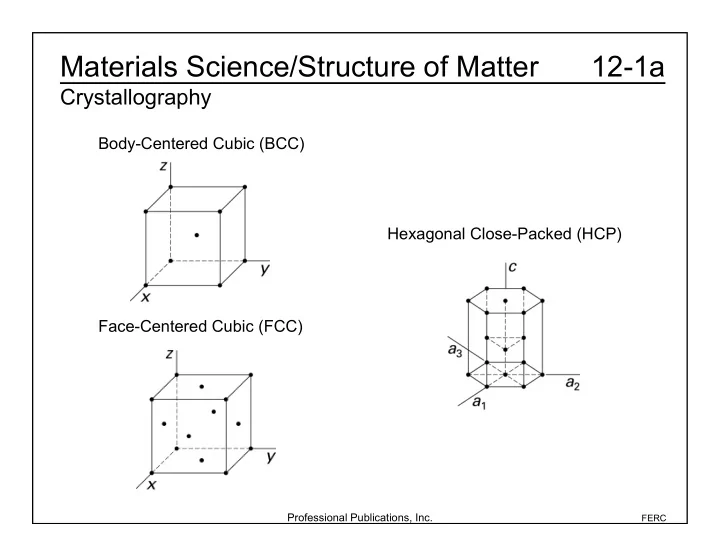

Materials Science/Structure of Matter 12-1a Crystallography Body-Centered Cubic (BCC) Hexagonal Close-Packed (HCP) Face-Centered Cubic (FCC) Professional Publications, Inc. FERC
Materials Science/Structure of Matter 12-1b Crystallography Atoms per cell • BCC: 2 • FCC: 4 • HCP: 6 Professional Publications, Inc. FERC
Materials Science/Structure of Matter 12-1c Crystallography Packing Factor • BCC: 0.68 • FCC: 0.74 • HCP: 0.74 Coordination Number • The number of the closest (touching) atoms • FCC, HCP: 12 • BCC: 8 Professional Publications, Inc. FERC
Materials Science/Structure of Matter 12-1d Crystallography Miller Indices • Specify planes in crystalline lattices • Calculated as the reciprocals of the plane intercepts The following ARE NOT valid Miller indices: ( ) (026) (-111) 1 1 3 4 4 4 The following ARE valid Miller indices: _ (113) (013) (1 11) Example (FEIM): What are the Miller indices of the series of planes shown? The intercept on the a axis is 1/2, so the a Miller index is 2. The intercept on the b axis is 1, so the b Miller index is 1. The plane intercepts the c axis at ∞ , so the c Miller index is 0. The Miller indices are (210). Professional Publications, Inc. FERC
Materials Science/Structure of Matter 12-2 Atomic Bonding Atomic Bonding • Ionic • Covalent • Metallic Example (FEIM): Which of the following has a bond that is the least ionic in character? (A) NaCl (B) CH 4 (C) H 2 (D) H 2 O The NaCl is entirely ionic. In the CH 4 and H 2 O, the hydrogen shares a pair of electrons with both the carbon and the oxygen in covalent bonds, but the carbon and oxygen have a larger share of the probability distribution than the hydrogen. In the H 2 , the two hydrogen have equal pull on the two shared electrons, so this bond is entirely covalent and the least ionic. Therefore, (C) is correct. Professional Publications, Inc. FERC
Materials Science/Structure of Matter 12-3a Metallurgy Corrosion Anode reaction (oxidation): 0 � M n + + ne M � Cathode reaction (reduction): 2 O 2 + 2e � + H 2 O � 2OH � 1 � + 2H 3 O + � 3H 2 O 2 O 2 + 2e 1 � + 2H 3 O + � 2H 2 O + H 2 2e Oxidation potential • If two metals have oxidation potentials that are close, corrosion will be very slow or negligible. • If two metals have very dissimilar oxidation potentials, corrosion will occur much faster. Professional Publications, Inc. FERC
Materials Science/Structure of Matter 12-3b Metallurgy Diffusion Movement of defects through a crystal is governed by the diffusion coefficient: Professional Publications, Inc. FERC
Materials Science/Structure of Matter 12-4a Binary Phase Diagrams • Show the equilibrium phase concentrations. Professional Publications, Inc. FERC
Materials Science/Structure of Matter 12-4b Binary Phase Diagrams Lever Rule Professional Publications, Inc. FERC
Materials Science/Structure of Matter 12-4c1 Binary Phase Diagrams Professional Publications, Inc. FERC
Materials Science/Structure of Matter 12-4c2 Binary Phase Diagrams Example (FEIM): An alloy at 800°C is 2% carbon by weight. What are the compositions and fractions of austenite ( γ ) and cementite (iron carbide) in the mixture? Follow the 800°C line to the left until it intersects the ( γ ) phase line; the austenite is about 1% carbon. Follow the 800°C line to the right until it intersects the carbide line; the cementite is about 6.67% carbon. � � � � x carbide � x 100% = 6.67 � 2 wt% � = 100% = 82.4% � � � � x carbide � x � 6.67 � 1 � � � � � x � x � � � � 2 � 1 wt% carbide = 100% = 100% = 17.6% � � � � x carbide � x � 6.67 � 1 � � � � Professional Publications, Inc. FERC
Materials Science/Structure of Matter 12-5 Thermal Processing • If rapid changes are made to the temperature of some alloys, they will not come to the new equilibrium state and will end up with properties that are different and perhaps useful. Professional Publications, Inc. FERC
Materials Science/Structure of Matter 12-6 Testing Methods • Standard Tensile Test • Endurance Test • Impact Test Professional Publications, Inc. FERC
Recommend
More recommend